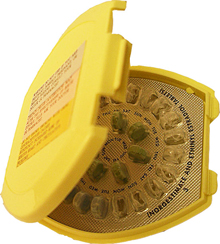 There are dozens of variations on the birth-control pill, all of which have differing amounts of various chemicals simulating two hormones: progesterone (produced by the placenta during pregnancy) and estrogen (produced by the ovaries as they mature and release eggs). The popularity of certain brands may be tied more to their manufacturers' advertising budgets than anything else; variations on the Pill are among the most heavily-marketed drugs in the marketplace.
There are dozens of variations on the birth-control pill, all of which have differing amounts of various chemicals simulating two hormones: progesterone (produced by the placenta during pregnancy) and estrogen (produced by the ovaries as they mature and release eggs). The popularity of certain brands may be tied more to their manufacturers' advertising budgets than anything else; variations on the Pill are among the most heavily-marketed drugs in the marketplace.
Typically, the Pill works by tricking a woman’s body into thinking it is already pregnant. That prevents ovulation, in which an egg is released from an ovary into the fallopian tubes, ready to be fertilized and to implant in the uterine lining. The various types of pills also have differing side effects, and some are thought to have lower incidence of certain side effects. Side effects vary not only from pill type to pill type, but from woman to woman.
The major commercially available brands of birth-control pills range in level from 0.05 mg of a synthetic progesterone (levonorgestronel, in Triphasil, Tri-Levlen, and Trivora) to 3 mg of another (drospirenone, in Yasmin), and from no estrogen at all (in Ortho Micronor and DepoSubQ-Provera, also called “the shot”) to 0.05 mg ethinyl estradiol (in Necon 1/50, Norinyl 1/50, Ortho-Novum 1/50, and Ovcon-50). Those with no estrogen, also known as “progesterone-only” pills, generally have fewer side-effects, because they do not have any estrogen in them to cause more.
Generally speaking, birth-control pills’ side effects can include nausea, headaches, mood changes, blood-pressure changes, skin problems, skin improvements, changes in the internal texture or external appearance of the breasts, vaginal irritation, urinary-tract infections, and irregular bleeding (also called “breakthrough bleeding” or “spotting”). Consult your doctor and read the documents accompanying your specific brand of pills to find out more.
SOURCES: Pill manufacturers’ Web sites, www.clevelandclinic.org
ADVERTISEMENT
 |